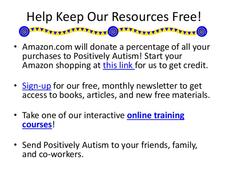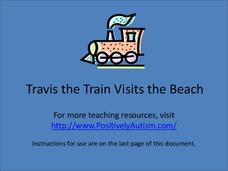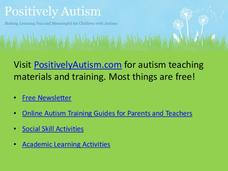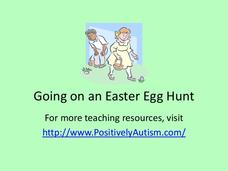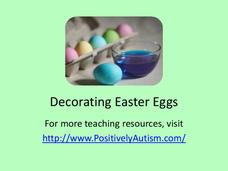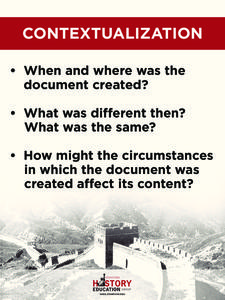Positively Autism
Travis the Train Delivers Shapes
Triangle, circle, square, rectangle, oval, star, diamond, heart. Travis the Train delivers eight shapes for learners with autism to identify. Part of a learning unit on shapes.
Positively Autism
Travis the Train Visits the Beach
Part of a unit on the seasons, in this resource Travis the Train introduces autistic learners to the ocean, beach balls, sand castles, pails, shovels, and sea shells. The final pages review the names of the images included in the lesson.
Positively Autism
"The Napping House" Big and Little
The dog is big. The mouse is little. Using vocabulary words introduced in the previous lesson, kids read, or are read, sentences and examine images that contrast big and little.
Positively Autism
Spring Break Social Skill Story
Changes in routines can prove to be difficult for all kids, but especially for autistic learners. Here's a story designed to prepare kids for the change in schedule brought on by spring break.
Positively Autism
"The Napping House" Ways to Say Sleeping
Sleeping, dozing, snoozing. Five different ways to say sleeping are introduced in this presentation designed to preparing kids for a reading of The Napping House.
Positively Autism
Thanksgiving Vocabulary
Corn, cornbread, cranberry sauce, family. Introduce learners with autism to 13 vocabulary words associated with Thanksgiving. Each printed word is illustrated and presented against a golden background.
Positively Autism
Halloween Vocabulary
Pumpkins, ghosts, and skeletons. Introduce learners with autism to words associated with Halloween. There are no tricks in this treat.
Positively Autism
What to Expect on Halloween: A Halloween Social Story
Halloween can be scary but knowing what to expect can reduces stress. Here's a story that teaches learners with autism what to expect and how to behave on Halloween. Each page in the 10-page story features one part of a typical Halloween...
Positively Autism
"Trick or Treat" Cards
Perfect for non-verbal learners, these Trick or Treat cards say thanks in a big way. Children with autism can hand this Happy Halloween thank you card to houses visited or can wear a big copy attached to their costume.
Positively Autism
Travis the Train Goes Trick-or-Treating
Travis the Train is on the move again, and this time he and his friends are going trick-or-treating. The story, employing images and concepts introduced in earlier lessons in the series, models behaviors appropriate for the night.
Positively Autism
Thanksgiving Verbs
Bake, cook, eat, serve, travel. Five verbs associated with Thanksgiving are introduced to learners with autism. This is a presentation that features one printed word and an illustration of that word on each slide.
Positively Autism
"Going on an Easter Egg Hunt" Social Skill Story
Easter egg hunts are the focus of this social skill story that lets kids know what to expect and establishes expectations for behavior as well.
Positively Autism
"Decorating Easter Eggs" Social Skill Story
Prepare kids for Easter egg decorating with a social skills story that explains the process and details appropriate behavior for the activity.
Positively Autism
"What to Expect on Mother's Day" Social Story
Not only does this social story tell kids what to expect on Mother's Day but it also offers an explanation for why we celebrate moms and includes suggestions for possible Mother's Day gifts.
Positively Autism
"What to Expect on the Fourth of July" Social Story
The social story "What to Expect on the Fourth of July" not only lets learners with autism know what to expect on this very American holiday, but also explains what behaviors are appropriate when at a fireworks display or picnic.
Positively Autism
Fourth of July Vocabulary
Flag, fireworks, parade. Introduce learners with autism to nine words associated with the Fourth of July. Each word is illustrated with either a photograph or drawing.
Positively Autism
Morning Routine Picture Cards
Mornings can be a challenge. There's so much to remember do in so little time. Foster self-efficacy skills in learners of any ability level or age and reduce stress with these morning routine picture cards.
Stanford University
Close Reading
Here's a poster that highlights the skills needed for the close reading of primary source documents when gathering evidence to support historical claims.
Stanford University
Contextualization
Part of a series of posters designed to be used with a unit fostering the skills needed to read like a historian, this template models the questions researchers need to ask to contextualize a primary source document.
Stanford University
Corroboration
How do historians corroborate the information in a primary source document? They use the questions features on this poster!
Stanford University
Sourcing
What questions do historians ask when sourcing a document? Here's a poster that models these questions.
Stanford University
What Is History?
Five important tenets of any social studies class are available for young historians with a poster that defines history as an account of the past. It encourages learners to question reliability of an author's perspective, as well as to...
Teach Engineering
Earthquakes Living Lab: Designing for Disaster
Build and design to rock and roll. Pairs research building design in earthquake areas and use computer simulations to see the effects of earthquakes on buildings,. They then sketch and explain a building design that would withstand a...
Teach Engineering
Earthquakes Living Lab: The Theory of Plate Tectonics
Find out if your class agrees with Ice Age: Continental Drift ... or if it's just a fun family movie! Class members research the theory of continental drift, examine evidence of plate tectonics, connect this information to engineering,...
Other popular searches
- Class Newsletter
- Bill of Rights Newsletter
- Creating a Newsletter
- Newsletter Template
- Classroom Newsletters
- Autobiographies Newsletter
- Creating Newsletter
- Newsletter Writing
- Writing a Family Newsletter
- Back to School Newsletters
- Newsletter on Computer
- Student Newsletters


